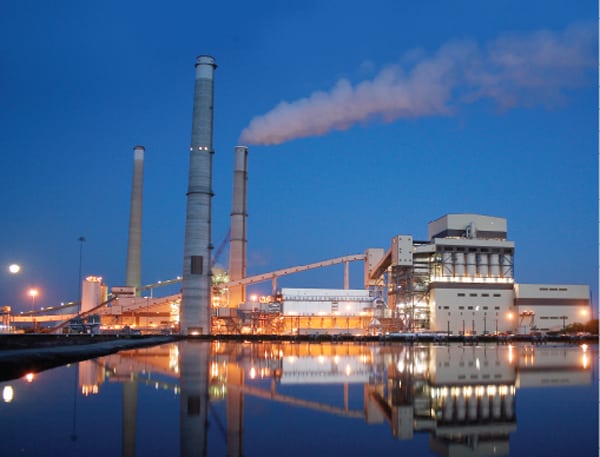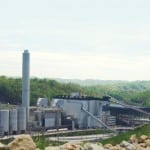Owner/operator: CPS Energy
CPS Energy, the largest municipally owned utility in the U.S. providing both natural gas and electric service, implemented an energy plan in 2003 that required energy conservation measures, use of available renewable energy sources such as wind and solar, and additional coal-fired generation. The $1 billion 750-MW Spruce 2 fits into that plan by being one of the cleanest coal-fired plants in the country.
 |
| Courtesy: Alstom Power |
In the U.S., where coal accounts for around 45% of generating capacity, new coal plants entering commercial service are becoming scarce. Moreover, those utilities with existing coal plants remain very busy installing costly new air quality control systems (AQCS) and other environmental protection systems. The cost of coal power is increasing, but it remains relatively inexpensive.
CPS Energy, based in San Antonio, Texas, is one utility that continues to rely on coal to fire about 38% of the electricity consumed by its customers. In total, CPS Energy has about 2,200 MW of coal-fired capacity in service today. In addition, the utility purchases the energy produced by five wind farms, totaling 859 MW, making it the largest municipal purchaser of wind energy in the U.S. The utility also purchases production from the 14-MW Blue Wing photovoltaic solar facility, the largest in the state of Texas, located on 113 acres southeast of San Antonio.
Clean Energy Strategy
CPS Energy’s Strategic Energy Plan was adopted by the Board of Trustees in June 2003. The plan set energy conservation goals, required increased use of renewable energy sources, and included an expansion of coal-fired generation.
In early 2005, the utility updated its strategic energy plan to address its future electricity generation needs. The plan was aligned with a fuel diversification program that would have the utility utilize coal, nuclear, and natural gas as well as increase the share of wind and solar in the energy mix.
With electricity demand climbing at approximately 3% per year at the time, CPS Energy’s forecasts indicated that an additional 1,300 MW would be required by 2013, and a significant new source of generation was needed by 2010 to meet that goal. As the utility had recently invested in two gas-fired plants, it determined that a coal-fired unit would be the best option to meet future electricity demand. A coal plant would ensure reliable supplies and diversify the utility’s energy supply by balancing scarce, high-priced, and volatile fuels with more plentiful and affordable ones. Ultimately, a coal plant would provide significant baseload electricity at low cost, and this would enable CPS Energy to pursue a balanced portfolio approach at affordable costs for its retail customers.
Planning Ahead
Later in 2005, Alstom Power was awarded contracts to supply equipment for a new $1 billion, 750-MW coal-fired unit: Spruce 2, at the utility’s Calaveras Power Station. Under the contracts, Alstom supplied a new coal-fired boiler as well as an AQCS, resulting in a plant that is one of the cleanest in the U.S. in terms of SOx, NOx, and particulate emissions.
There are also four other units at the site: the Sommers power plant (two gas-fired boilers) and the Deely power plant (two coal-fired units).
The new unit is located next to Spruce 1, a 550-MW coal-fired unit that began operation at the end of 1992 and was designed with provisions for an additional unit. Those provisions for a future Spruce 2 included much of the necessary infrastructure, such as the water treatment building, machine shop, coal-handling supply conveyors, and scrubber waste–handling equipment. That approach saved as much as $300 million in construction costs for the new unit.
The process of obtaining a permit from the Texas Commission on Environmental Quality to build Spruce 2 was challenging but ultimately successful. To obtain the permit, CPS Energy proposed emissions levels that were stricter than those established for SOx and NOx at the time for other plants in Texas.
The project was handled by Calaveras Power Partners LP (CPP), a consortium of Black & Veatch, TIC (The Industrial Company), and Zachry Construction. Following an evaluation of bids for the project, CPP awarded Alstom the contract to supply the boiler in September 2005 and the contract for the environmental control equipment a month later.
Under the first contract, Alstom was responsible for delivering the complete boiler island and the selective catalytic reduction (SCR) equipment. The scope of supply included fans, motors, boiler water circulation pumps, valves, coal mills, bottom ash equipment, and air heaters—essentially, all equipment connected to the air heater outlet.
Under a separate contract for environmental control equipment, Alstom supplied a reverse gas fabric filter to reduce particulates and a wet flue gas desulfurization (FGD) system to remove SO2, hydrogen chloride, and hydrogen fluoride.
 |
| 1. Younger sibling. CPS Energy completed construction of its second Spruce unit, the 750-MW Spruce 2, just in time to meet the summer 2010 peak demand season (May through September). The $1 billion plant took 50 months to construct. Courtesy: Alstom Power |
The Proper Way to Burn Coal
The boiler at Spruce 2 utilizes a subbituminous low-sulfur coal delivered by train from Wyoming’s Powder River Basin. One to two trains arrive each day, with each train comprising 135 cars and carrying more than 100 tons of coal per car.
Coal is unloaded from the trains to the coal yard and transported to silos large enough to provide 12 hours of storage at the plant. Spruce 2 consumes 425 tons/hour of coal. The coal is pulverized and dried in bowl mills before being combusted; five of the six bowl mills are required to achieve full load.
The boiler is a two-pass design with straight wall furnace tubing. The design main steam temperature measured at the superheater outlet is 1,050F. The in-furnace NOx control reduces NOx at the boiler outlet to approximately 0.12 lb/MMBtu. The SCR, CPS Energy’s first SCR system on a coal-fired unit, further reduces NOx emission to about 0.05 lb/MMBtu at the stack.
A reverse gas fabric filter removes particulate emissions. The fly ash collected is reused in the cement industry, while the bottom ash is used for roadbed and other construction applications; consequently, there is very little disposal of ash waste products on site. CPS Energy has been meeting its particulate emissions and opacity targets since the start of operation.
Upon leaving the baghouse and induced draft fans, the flue gas enters a wet FGD for the final stage of cleaning. The wet scrubber is an open spray tower, wherein the reactive slurry from the tank portion of the vessel is recirculated to the top of the tower and sprayed down onto the gas using a header with a series of nozzles. SO2 removal occurs as the flue gas is directed up and through a series of headers or spray levels that are spraying the limestone-based reactive slurry. The desulfurized gas exits the tower and goes to the stack. The solid by-product from the scrubber is gypsum. The wet FGD system has also achieved its design target emissions of less than 0.06 lb/MMBtu SO2, well below the levels required by the air permit.
The new unit uses cooling water taken from the man-made Calaveras Lake. From the outset, the control room was designed to house controls for both Spruce units. Operators can manage operation of the boiler, turbine, scrubber, and waste-handling system of each unit from this common control room.
Ready for the Peak
The erection of any coal-fired plant often presents significant challenges, but the erection of Spruce 2 by CPP proceeded well from start to finish. After a construction period lasting approximately four years, commercial operation began on May 28, 2010, just in time to meet the CPS Energy summer peak season (May through September), saving $45 million “compared to power that would have been purchased from the state grid” for that period, according to CPS Energy.
With electricity demand in the U.S. expected to grow by more than 25% through 2030, coal will continue to be an important fuel in the country’s energy mix. Reducing its environmental effects will always be the key. In fact, CPS Energy says that 25% of the Spruce 2 price tag was for equipment to meet environmental regulations. As one of the cleanest coal power plants in the country, Spruce 2 demonstrates how coal-fired plants can continue to have a long-term role in the nation’s energy mix.
— Dr. Robert Peltier, PE is POWER’s editor-in-chief.









